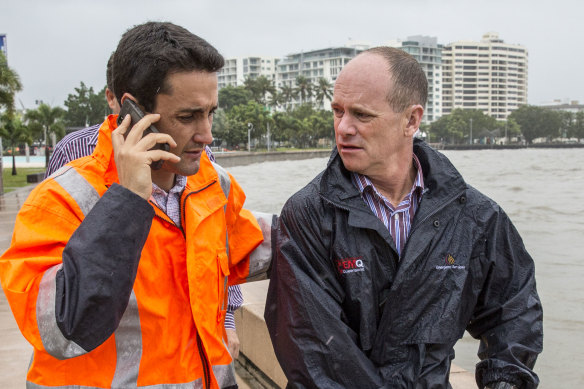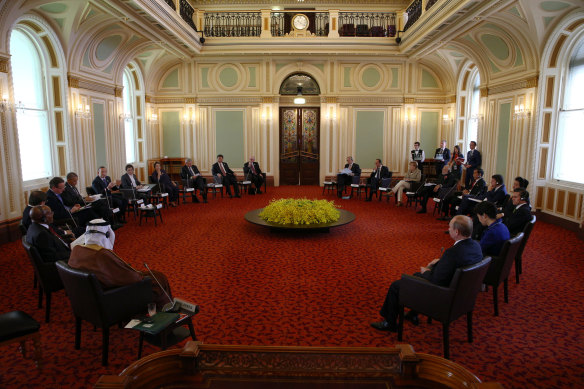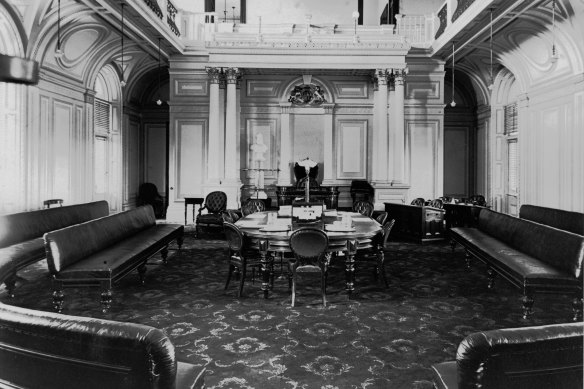- Perspective
- Politics
- Queensland
- Government
A Queensland Senate may be the only thing to protect the LNP from itself
It says a lot about the LNP that, in Queensland, it has been in power for a cumulative total of just 63 months since Wayne Goss finally brought an end to the Bjelke-Petersen era in 1989.
That’s 63 months out of a total 415. If my journalistic maths (a notoriously untrustworthy form of maths) is to be trusted, that’s just 15.2 per cent of the post-Joh era.
For a state that’s nationally defined as a bastion of conservatism, it’s quite the statistic.

David Crisafulli will have to defy post-Fitzgerald history to avoid Campbell Newman’s fate as a oncer, should he win in October.Credit: Glenn Hunt
So why has the Coalition-turned-LNP struggled to gain a foothold in what prevailing political wisdom suggests should be its heartland?
There’s no easy answer to that, but I would suggest a big part of it is the lack of an upper house.
In the context of Australian state parliaments, Queensland is uniquely unicameral. Every other state parliament has an upper house to provide checks and balances to the government of the day.
To understand why – and how – requires a quick history lesson.
It’s been about 102 years since our upper house, the Legislative Council, voted itself out of existence, despite more than 60 per cent of Queenslanders voting for its retention in a 1917 referendum.
Prior to the vote, Labor premier TJ Ryan advocated its abolition, describing the upper house as a “relic of feudalism”.
He had a point.
The Legislative Council was undemocratic, with every member appointed – not elected – to their posts. Wealth and privilege were the primary qualifications for members, who were given lifetime appointments by the Crown, through the governor.

Queensland’s old upper house is now used for mainly ceremonial purposes, including this meeting of world leaders during the 2014 G20.Credit: G20 Pool
The referendum did not end Labor’s determination to be done with the Legislative Council.
In 1921, at the behest of premier “Red” Ted Theodore, lieutenant-governor William Lennon added 14 Labor members to the council. This so-called “suicide squad” promptly voted the Legislative Council out of existence, which took effect on March 23, 1922.
In and of itself, that was a good thing for Queensland. The Legislative Council as it existed was, to borrow a term, unrepresentative swill. But that’s not to say an upper house does not have merit. A house of review can protect a government from itself, by forcing compromise and consultation.
How many terms would the Newman government have had with that approach? More than one, I would humbly suggest.
The lack of an upper house in Queensland has historically helped facilitate corruption to flourish; the National Party’s gerrymander helped keep the Coalition in power, despite the stench.
Premiers Rob Borbidge and Campbell Newman led the Coalition, then the LNP, to victories over unpopular Labor governments. If opinion polls on the current Labor government are to be believed, David Crisafulli will do the same in October.
Both times the conservatives came to power, it didn’t take long for them to let their crazy show. And both times, they were promptly dispatched at the first possible opportunity.
The past few decades suggest Crisafulli’s chances of being a oncer are high.

The Legislative Council Chamber in 1906, when it was still in use. Credit: John Oxley Library
There’s a federal parallel, too. Queensland turned against prime minister John Howard when his government, unchecked by the Senate having gained control of both houses in Canberra, went too far. WorkChoices, anyone?
The check and balance was gone, and Queensland didn’t like it. On the seat count, the Coalition’s 21-6 lead over Labor turned into a 15-13 deficit. (The fact Kevin Rudd was a Queenslander did Labor no harm.)
Back at the state level, the committee structure meant to compensate for the lack of an upper house has failed.
That was never more evident than in April, when a cross-party committee to look into youth justice collapsed, or in 2013, when the Newman government ran roughshod over the process altogether.
Some partisans may disagree, but Labor has generally been very conscious of its eternally perilous hold on power in Queensland. It has not been prone to governing only for its base and has, in the main, taken a very centrist approach – often to the chagrin of the party’s rank and file.
The same could not be said of the erstwhile LNP governments, which governed with an ideological bluster that put them offside with swathes of the population, particularly here in Brisbane.
A re-established upper house could prevent that.
Some would bemoan having even more politicians in George Street. With political dissatisfaction seemingly at stratospheric levels, that is not at all surprising, but a proportionally representative upper house would force the LNP (and Labor, should it retreat to the left) to be more consultative.
It would protect future governments from their worst instincts.
It may be a thorn in an LNP government’s side, but it could also be the secret to its longevity.